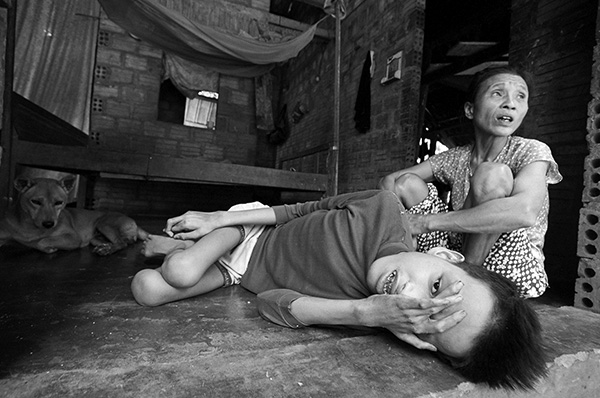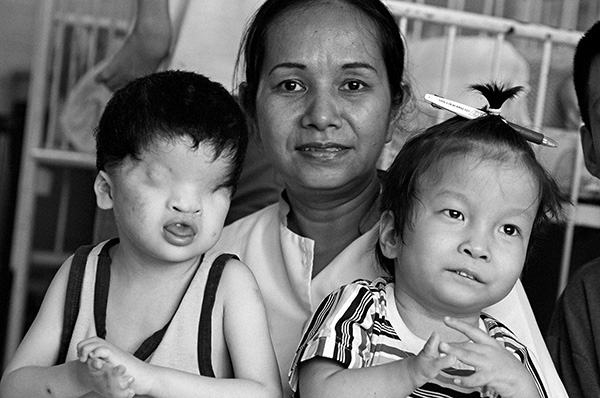Livio Senigalliesi: Imagine No Heaven
Title:Arancio indelebile - La guerra infinita © Livio Senigalliesi for Emergency.org
Time: 4 min. 14 sec.
Language of text: Italian
Vietnam
VIETNAM – THE LEGACY OF AGENT ORANGE
Photos and text by Livio Senigalliesi
North Vietnamese forces entered Saigon on 30 April 1975, bringing the Vietnam War to an end – but not for everyone. Four million Vietnamese still bear the consequences of Agent Orange, the dioxin-contaminated defoliant which was sprayed by the US Air Force for ten years from 1961 over the forest territories in which the Viet Cong nestled.
Operation ‘Ranch Hand’ aimed to clear the forest and let US bomber crews napalm the enemy or drop high-explosives on them from their B-52s. To this day, the children of those that survived are forced to live with severe pathologies, and want justice. Thousands of kilometres of land along the border between Laos, Vietnam and Cambodia has been reduced to desert. The damage to nature and people is irreversible. Scientists have defined it as ecocide.
Putting together this piece of reportage was like coming full circle for me. A story that began back in Milan with the anti-war protests of the ‘70s found its end during summer 2006 by my going all the way up the Mekong delta with a camera round my neck, thinking back to the historic pictures by Larry Burrows published in Life magazine.
Accompanied by Mr. Nguyen Huy Quang, an official from Hanoi’s Ministry of Information, I travelled along the ‘Ho Chi Minh Trail’, penetrating those depths of the jungle where the fighting had taken place 40 years before. I wanted to understand the scope of the problem, so I met with peasant families whose kids will be bodily and mentally scarred forever. The conditions of the people affected by ‘Agent Orange Syndrome’ are terrible. Here are some of their stories, tales which should make us pause, and ponder the long-term consequences of chemical warfare.
Cam Nghĩa, in Quảng Trị province, belonged to the Viet Cong during the War; now it’s been labelled the ‘cursed village’. For the past 22 years, Nguyen Van Lahn has lain on a mat in a room as dark as a cavern. The silence is lacerated by the shrieks issued from his mouth. His hands have been bound with a cloth to stop him hurting himself, whilst his mother Le Thi Mit caresses him and does everything in her power to keep him calm. For folk like this there’s no cure – they’re forced to vegetate and await death.
 Le Thi Mit expresses gratitude for my visit and recalls the war time: “Several times a day, planes flew overhead and scattered around a strong-smelling yellowish cloud. It felt suffocating; it made our eyes water. After three days all the leaves would turn yellow and begin to fall from the trees. Then the American bombers would come… we spent weeks in the underground tunnels. Nobody warned us of the danger that substance carried, and for years we carried on drinking from our wells and eating what grew in the ground. It was a matter of survival. After the war I fell pregnant 11 times but all my children were born deformed and sick. The most rapidly died. Van Lan and Van Truong are still alive.Who will take care of them when I'm gone? “
Le Thi Mit expresses gratitude for my visit and recalls the war time: “Several times a day, planes flew overhead and scattered around a strong-smelling yellowish cloud. It felt suffocating; it made our eyes water. After three days all the leaves would turn yellow and begin to fall from the trees. Then the American bombers would come… we spent weeks in the underground tunnels. Nobody warned us of the danger that substance carried, and for years we carried on drinking from our wells and eating what grew in the ground. It was a matter of survival. After the war I fell pregnant 11 times but all my children were born deformed and sick. The most rapidly died. Van Lan and Van Truong are still alive.Who will take care of them when I'm gone? “
90% of children affected by the syndrome are abandoned by their families as soon as they’re born and spend all their lives in hospital or in specialist centres managed by the VAVA association (The Vietnam Association of Victims of Agent Orange/Dioxin). The most severe half a million cases are treated in dedicated facilities like the Từ Dũ Hospital in Ho Chi Minh City. There, they have a ‘dark room’, where hundreds of still-born foetuses – or babes who succumbed to severe malformations as soon as they came into the world – areconserved in formaldehyde jars. Wandering around the hospital’s wards you bump into children of all age-groups; they come from the Mekong delta, Kon Tum province, or the other regions bordering Laos and Cambodia.
 I can’t conceal my despair in the face of such suffering. Geared up by the desire to document this human tragedy, I kept taking pictures, always in the most respectful way towards the victims, but somehow I felt restrained. Compassion was overwhelmingly stronger than my sense of duty. Those pictures had to be taken but more often than not I gave in to long enforced breaks, with tears streaming down my face.
I can’t conceal my despair in the face of such suffering. Geared up by the desire to document this human tragedy, I kept taking pictures, always in the most respectful way towards the victims, but somehow I felt restrained. Compassion was overwhelmingly stronger than my sense of duty. Those pictures had to be taken but more often than not I gave in to long enforced breaks, with tears streaming down my face.
There are stories which leave a mark forever – Duc and Viet’s is one. They were taken to the Từ Dũ as new-borns. The twins came from the Sa Thầy district in Kon Tum province, one of the most dioxin-contaminated areas. Joined at the hip, with a single pelvis, penis and only two legs, they underwent an operation and were divided at the age of 8. Duc’s destiny has been much more favourable. His IQ was within the norm and, despite the physical issues, he was able to study and, later, joined the hospital staff. His brother Viet, under the care of medics and his mother Lam Thi, vegetates in bed.
Biên Hòa too, at the mouth of River Mekong, is severely contaminated. Planes engaged in ‘Ranch Hand’ took off from the US Air Base here. There are thousands of deformed children housed in the Agent Orange Victims Centre. Recent tests carried out on the people, animals and water table of the affected area confirm that the dioxin concentration remains sky-high. Brought about by ecological disaster, the contamination is propagated to this day via the food chain. The dioxin, having been swallowed with food or breast milk, circulates, and reaches the target organs, causing DNA mutations or cancers, which in turn produce an infinite string of sufferings, and a devastating impact on society.
For years, VAVA has asked the United States to pay war reparations, to provide the victims with assistance and to decontaminate the areas still widely polluted by the deadly herbicide. But the US – whilst being one of Vietnam’s main commercial partners – reject all charges. No way to reclaim these immense regions has yet been invented; plus, the Americans don’t want to create dangerous precedents. If they were to compensate all permanent damages inflicted on innocent civilians during the Vietnam, Korea, Iraq, Afghanistan and Balkan wars, the world’s great superpower would bankrupt itself, and be left a victim of its own killing streak and years of bloody imperialism.
VIETNAM – THE LEGACY OF AGENT ORANGE